Geoarchaeological Investigation of Abydos Area Using Land Magnetic and GPR Techniques, El-Balyana, Sohag, Egypt
Abstract
1. Introduction
2. Location and History of Study Area
3. Geological Study
4. Material and Methods
4.1. Land Magnetic Survey
4.2. Ground Penetrating Radar
5. Data Processing
5.1. Magnetic Data Processing
5.2. GPR Data Processing
6. Results and Discussion
6.1. Magnetic Results
6.2. GPR Results
7. Conclusions
Author Contributions
Funding
Data Availability Statement
Acknowledgments
Conflicts of Interest
References
- El All, E.A.; Khalil, A.; Rabeh, T.; Osman, S. Geophysical contribution to evaluate the subsurface structural setting using magnetic and geothermal data in El-Bahariya Oasis, Western Desert, Egypt. NRIAG J. Astron. Geophys. 2015, 4, 236–248. [Google Scholar] [CrossRef]
- Abbas, A.M.; Kamei, H.; Helal, A.; Atya, M.A.; Shaaban, F.A. Contribution of geophysics to outlining the foundation structure of the Islamic Museum, Cairo, Egypt. Archaeol. Prospect. 2005, 12, 167–176. [Google Scholar] [CrossRef]
- Tzanis, A. MatGPR (Release 3), Manual and Technical Reference; University of Athens; Department of Geophysics: Athens, Greece, 2013. [Google Scholar]
- Daniels, D.J. Surface-penetrating radar. Electron. Commun. Eng. J. 1996, 8, 165–182. [Google Scholar] [CrossRef]
- Davis, J.L.; Annan, A.P. Ground-penetrating radar for high-resolution mapping of soil and rock stratigraphy 1. Geophys. Prospect. 1989, 37, 531–551. [Google Scholar] [CrossRef]
- Gaber, H.A.; Abudeif, A.M.; Mohammed, M.A.; AbdelAal, G.Z.; Mansour, K.K. Archaeological prospecting on the site of Osirion-Abydos using High Resolution Ground Penetrating Radar Technique, Sohag District, Egypt. Sohag J. Sci. 2022, 7, 115–122. [Google Scholar]
- Mohammed, M.A.; Abudeif, A.M.; AbdelAal, G.Z.; Gaber, H.A. Archaeogeophysical study on the Abydos Temple site using Ground Penetrating Radar Technique, Sohag Governorate, Egypt. In Proceedings of the Fifth International Conference on New Horizons in Basic and Applied Sciences. Organized by Faculty of Science (Assiut) Al-Azhar University, Hurghada, Egypt, 26–29 September 2021. [Google Scholar]
- El Emam, A.; Lethy, A.; Radwan, A.M.; Awad, A. Archaeological investigation and hazard assessment using magnetic, ground-penetrating radar, and GPS tools at Dahshour Area, Giza, Egypt. Front. Earth Sci. 2021, 9, 674953. [Google Scholar] [CrossRef]
- Derda, T.; Gwiazda, M.; Misiewicz, K.; Małkowski, W. Marea/Northern Hawwariya in northern Egypt: Integrated results of non-invasive and excavation works. Archaeol. Prospect. 2021, 28, 123–136. [Google Scholar] [CrossRef]
- Yousef, S.B.; Yousef, M.H.; Abd-Elsalam, H.F.; Shaheen, M.A. Detection of the Possible Buried Archeological Targets Using the Geophysical Methods of Ground Penetrating Radar (GPR) and Self Potential (SP), Kom Ombo Temple, Aswan Governorate, Egypt. Geomaterials 2020, 10, 105. [Google Scholar] [CrossRef]
- Mohamed, A.-M.S.; Atya, M.; AbouAly, N.; Farragawy, K.E.; Hegazy, E.E.; Saleh, M.; Kabeel, K.; El-Mahdi, A.A. Mapping the archaeological relics of catacombs at Northeast Saqqara using GPR data, Egypt. NRIAG J. Astron. Geophys. 2020, 9, 362–374. [Google Scholar] [CrossRef]
- Ibrahim, H.A.; Ebraheem, M.O. Ground-penetrating radar reflections and their archaeological significances at two ancient necropolis tombs in Kharga Oasis, Egypt. Near Surf. Geophys. 2020, 18, 713–728. [Google Scholar] [CrossRef]
- Ahmed, S.B.; El Qassas, R.A.; El Salam, H.F.A. Mapping the possible buried archaeological targets using magnetic and ground penetrating radar data, Fayoum, Egypt. Egypt. J. Remote Sens. Space Sci. 2020, 23, 321–332. [Google Scholar] [CrossRef]
- Mohammed, M.; Abudeif, A. Applications of electrical resistivity for construction in Al Kawamil, Sohag, Egypt: A case study. J. Environ. Eng. Geophys 2019, 24, 327–332. [Google Scholar] [CrossRef]
- El-Qady, G.; Metwaly, M.; Drahor, M.G. Geophysical techniques applied in archaeology. In Archaeogeophysics; Springer: Berlin/Heidelberg, Germany, 2019; pp. 1–25. [Google Scholar]
- Gaber, A.; El-Qady, G.; Khozym, A.; Abdallatif, T.; Kamal, S.A. Indirect preservation of Egyptian historical sites using 3D GPR survey. Egypt. J. Remote Sens. Space Sci. 2018, 21, S75–S84. [Google Scholar] [CrossRef]
- Gaballah, M.; Grasmueck, M.; Sato, M. Characterizing subsurface archaeological structures with full resolution 3D GPR at the early dynastic foundations of Saqqara Necropolis, Egypt. Sens. Imaging 2018, 19, 1–15. [Google Scholar] [CrossRef]
- Hemeda, S.; Pitilakis, K. Geophysical investigations at Cairo’s oldest, the church of Abu Serga (st. sergius), Cairo, Egypt. Res. Nondestruct. Eval. 2017, 28, 123–149. [Google Scholar] [CrossRef]
- Gavazzi, B.; Alkhatib-Alkontar, R.; Munschy, M.; Colin, F.; Duvette, C. On the use of Fluxgate 3-Axis magnetometers in archaeology: Application with a multi-sensor device on the site of Qasr ‘Allam in the Western Desert of Egypt. Archaeol. Prospect. 2017, 24, 59–73. [Google Scholar] [CrossRef]
- Abbas, A.M.; Ghazala, H.H.; Mesbah, H.S.; Atya, M.A.; Radwan, A.; Hamed, D.E. Implementation of ground penetrating radar and electrical resistivity tomography for inspecting the Greco-Roman Necropolis at Kilo 6 of the Golden Mummies Valley, Bahariya Oasis, Egypt. NRIAG J. Astron. Geophys. 2016, 5, 147–159. [Google Scholar] [CrossRef][Green Version]
- Abbas, A.M.; Salah, H.; Massoud, U.; Fouad, M.; Abdel-Hafez, M. GPR scan assessment at Mekaad Radwan Ottoman–Cairo, Egypt. NRIAG J. Astron. Geophys. 2015, 4, 106–116. [Google Scholar] [CrossRef][Green Version]
- El Emam, A.; Abdallatif, T.; Suh, M.; Odah, H. Delineation of Egyptian mud bricks using magnetic gradiometer techniques. Arab. J. Geosci. 2014, 7, 489–503. [Google Scholar] [CrossRef]
- Odah, H.; Ismail, A.; Elhemaly, I.; Anderson, N.; Abbas, A.M.; Shaaban, F. Archaeological exploration using magnetic and GPR methods at the first court of Hatshepsut Temple in Luxor, Egypt. Arab. J. Geosci. 2013, 6, 865–871. [Google Scholar] [CrossRef]
- Mekkawi, M.; Arafa-Hamed, T.; Abdellatif, T. Detailed magnetic survey at Dahshour archeological sites Southwest Cairo, Egypt. NRIAG J. Astron. Geophys. 2013, 2, 175–183. [Google Scholar] [CrossRef][Green Version]
- Atya, M.; Al Khateeb, S.; Ahmed, S.; Musa, M.; Gaballa, M.; Abbas, A.; Shaaban, F.; Hafez, M. GPR investigation to allocate the archaeological remains in Mut temple, Luxor, Upper Egypt. NRIAG J. Astron. Geophys. 2012, 1, 12–22. [Google Scholar] [CrossRef]
- Abbas, A.M.; Atya, M.; El Emam, A.; Shaaban, F.F.; Odah, H.H.; Lethy, A.M. Integrated Geophysical Studies to Image the Remains of Amenemeht II Pyramid’s Complex in Dahshour Necropolis, Giza, Egypt. J. Pet. Min. Eng 2011, 14, 27–51. [Google Scholar]
- Abbas, A.M.; Abdallatif, T.F.; Shaaban, F.A.; Salem, A.; Suh, M. Archaeological investigation of the eastern extensions of the Karnak Temple using ground-penetrating radar and magnetic tools. Geoarchaeology:Int. J. 2005, 20, 537–554. [Google Scholar] [CrossRef]
- Khozym, A. Geophysical Prospection of Some Archaeological Sites in Saqqara Area, Giza, Egypt. Unpublished Master’s Thesis, Ain Shams University, Cairo, Egypt, 2003. [Google Scholar]
- Ismail, A.M.A. Geophysical, Hydrological, and Archaeological Investigation in the East Bank Area of Luxor-Southern Egypt; University of Missouri-Rolla: Rolla, MO, USA, 2003. [Google Scholar]
- Ghazala, H.; El-Mahmoudi, A.; Abdallatif, T. Archaeogeophysical study on the site of Tell Toukh El-Qaramous, Sharkia Governorate, East Nile Delta, Egypt. Archaeol. Prospect. 2003, 10, 43–55. [Google Scholar] [CrossRef]
- Kamei, H.; Atya, M.A.; Abdallatif, T.F.; Mori, M.; Hemthavy, P. Ground-penetrating radar and magnetic survey to the west of Al-Zayyan Temple, Kharga Oasis, Al-Wadi Al-Jadeed (New Valley), Egypt. Archaeol. Prospect. 2002, 9, 93–104. [Google Scholar] [CrossRef]
- Elbassiony, A. Geophysical Archaeoprospection in Saqqara and Qantir Areas, Egypt. Unpublished Master’s Thesis, Ain Shams University, Cairo, Egypt, 2001. [Google Scholar]
- Shaaban, F.; Shaaban, F.; Abbas, A.; El-Essawy, A. Mapping of buried archaeological relics using GPR survey at the Isis Temple, Bahbeit El-Hegara Area, Egypt. In Bulletin of National Research Institute of Astronomy and Geophysics (NRIAG); NRIAG Journal of Astronomy and Geophysics: Cairo, Egypt, 2003; pp. 111–133. [Google Scholar]
- Rhee, J.-Y.; Park, K.-T.; Cho, J.-W.; Lee, S.-Y. A Study of the Application and the Limitations of GPR Investigation on Underground Survey of the Korean Expressways. Remote Sens. 2021, 13, 1805. [Google Scholar] [CrossRef]
- Leucci, G.; De Giorgi, L.; Ditaranto, I.; Miccoli, I.; Scardozzi, G. Ground-Penetrating Radar Prospections in Lecce Cathedral: New Data about the Crypt and the Structures under the Church. Remote Sens. 2021, 13, 1692. [Google Scholar] [CrossRef]
- Forte, E.; Mocnik, A.; Basso, P.; Casagrande, G.; Martinucci, D.; Pillon, S.; Possamai, M.; Zambrini, R. Optimised extraction of archaeological features from full 3-d gpr data. Appl. Sci. 2021, 11, 8517. [Google Scholar] [CrossRef]
- Verdonck, L.; Launaro, A.; Vermeulen, F.; Millett, M. Ground-penetrating radar survey at Falerii Novi: A new approach to the study of Roman cities. Antiquity 2020, 94, 705–723. [Google Scholar] [CrossRef]
- Solla, M.; Fransisco, C.; Gonçalves, L.; Gonçalves, G.; Puente, I.; Providência, P.; Gaspar, F.; Puente, I.; Rodrigues, H. Integrating GPR and Geomatic Data into a Building Information Modelling: The Case Study of the Monastery of Batalha (Portugal); Defense University Center (Spanish Naval Academy): Marín, Spain, 2020. [Google Scholar]
- Ristić, A.; Govedarica, M.; Pajewski, L.; Vrtunski, M.; Bugarinović, Ž. Using ground penetrating radar to reveal hidden archaeology: The case study of the Württemberg-Stambol Gate in Belgrade (Serbia). Sensors 2020, 20, 607. [Google Scholar] [CrossRef] [PubMed]
- Yilmaz, S.; Balkaya, Ç.; Cakmak, O.; Oksum, E. GPR and ERT explorations at the archaeological site of Kılıç village (Isparta, SW Turkey). J. Appl. Geophys. 2019, 170, 103859. [Google Scholar] [CrossRef]
- Ortega-Ramírez, J.; Bano, M.; de Larrea-López, L.L.; Robles-Camacho, J.; Ávila-Luna, P.; Villa-Alvarado, L. GPR measurements to identify cracks and textural arrangements in the altar wall of the 16th-century Santa Maria Huiramangaro Church, Michoacán, Mexico. Near Surf. Geophys. 2019, 17, 247–261. [Google Scholar] [CrossRef]
- Casas, A.; Cosentino, P.L.; Fiandaca, G.; Himi, M.; Macias, J.M.; Martorana, R.; Muñoz, A.; Rivero, L.; Sala, R.; Teixell, I. Non-invasive geophysical surveys in search of the Roman Temple of Augustus under the Cathedral of Tarragona (Catalonia, Spain): A case study. Surv. Geophys. 2018, 39, 1107–1124. [Google Scholar] [CrossRef]
- Welc, F.; Mieszkowski, R.; Lipovac-Vrkljan, G.; Konestra, A. An attempt to integration of different geophysical methods (magnetic, GPR and ERT); a case study from the late Roman settlement on the Island of Rab in Croatia. Studia Quat. 2017, 34, 47–59. [Google Scholar] [CrossRef]
- Vanvalkenburgh, P.; Walker, C.P.; Sturm, J.O. Gradiometer and ground-penetrating radar survey of two reducción settlements in the Zaña Valley, Peru. Archaeol. Prospect. 2015, 22, 117–129. [Google Scholar] [CrossRef]
- Mohamad, M.H.; Nawawi, M.; Adlan, M.N.; Abdullah, K. Studying Effect of Riverbank Filtration (RBF) on Ground Water Using ‘Time-Lapse Electrical Resistivity Imaging’at Kuala Kangsar, Perak. Appl. Mech. Mater. 2015, 802, 605–610. [Google Scholar] [CrossRef]
- Cella, F.; Fedi, M. High-resolution geophysical 3D imaging for archaeology by magnetic and EM data: The case of the iron age settlement of Torre Galli, Southern Italy. Surv. Geophys. 2015, 36, 831–850. [Google Scholar] [CrossRef]
- Ekinci, Y.L.; Balkaya, Ç.; Şeren, A.; Kaya, M.A.; Lightfoot, C.S. Geomagnetic and geoelectrical prospection for buried archaeological remains on the Upper City of Amorium, a Byzantine city in midwestern Turkey. J. Geophys. Eng. 2014, 11, 015012. [Google Scholar] [CrossRef]
- Sarris, A.; Papadopoulos, N. Looking for graves: Geophysical Prospection of cemeteries. In Proceedings of the 16th International Congress on “Cultural Heritage and New Technologies”, Vienna, Austria, 14–16 November 2012. [Google Scholar]
- Alashloo, S.M.; Saad, R.; Nawawi, M.; Saidin, M.; Alashloo, M. Magnetic and 2D electrical imaging methods to investigate an archaeological site at Sungai Batu, Kedah, Malaysia. In Proceedings of the 3rd International Conference on Chemical, Biological and Environmental Engineering, IPCBEE, Chengdu, China, 23–25 September 2011. [Google Scholar]
- Nuzzo, L.; Leucci, G.; Negri, S. GPR, ERT and magnetic investigations inside the Martyrium of St Philip, Hierapolis, Turkey. Archaeol. Prospect. 2009, 16, 177–192. [Google Scholar] [CrossRef]
- Mori, G. The Use of Ground Penetrating Radar and Alternative Geophysical Techniques for Assessing Embankments and Dykes Safety. Ph.D. Thesis, Alma Mater Studiorum University of Bologna, Bologna, Italy, 2009. [Google Scholar]
- Schmidt, A. Archaeology, magnetic methods. In Encyclopedia of Geomagnetism and Paleomagnetism; Springer: Berlin/Heidelberg, Germany, 2007; pp. 23–31. [Google Scholar]
- Rizzo, E.; Chianese, D.; Lapenna, V. Magnetic, GPR and geoelectrical measurements for studying the archaeological site of ‘Masseria Nigro’(Viggiano, southern Italy). Near Surf. Geophys. 2005, 3, 13–19. [Google Scholar] [CrossRef]
- Abdel-Hafez, T. Geophysical and Geotechnical Studies in Pharaonic and Urban Egypt; Citeseer; Bern University: Bern, Swiss, 2004. [Google Scholar]
- UNESCO. World Heritage Centre.mht. In Abydos, City of Pilgrimage of the Pharaohs; WHC-03/27.COM/24; UNESCO: Paris, France, 2003. [Google Scholar]
- Hawass, Z. New Discoveries at Abydos; Horus Magazine Edition January/March; The American University in Cairo Press: Cairo, Egypt, 1998; pp. 392–400. [Google Scholar]
- Baedeker, S. Egypt from A to Z. Handbook for Travellers; Jarrold and Sons Ltd.: Cairo, Egypt, 1978. [Google Scholar]
- Abudeif, A.; Fat-Helbary, R.; Mohammed, M.; El-Khashab, H.; Masoud, M. Estimation of the site effect using microtremor technique at new Akhmim city, Akhmim, Sohag, Egypt. Russ. Geol. Geophys. 2019, 60, 231–239. [Google Scholar] [CrossRef]
- Brooks, J.E.; Issawi, B. Groundwater in the Abydos Areas, Egypt; The Flooding of the Osireion: Egyptian Journal of Archaeological and Restoration Studies “EJARS”: Cairo, Egypt, 1992. [Google Scholar]
- Wendorf, F.; Schild, R. Prehistory of the Nile valley; Academic Press: Cambridge, MA, USA, 2014. [Google Scholar]
- Said, R.; Wendorf, F.; Schild, R. The geology and prehistory of the Nile Valley in Upper Egypt. Archaeol. Pol. 1970, 12, 43–60. [Google Scholar]
- Omer, A. Geological, Mineralogical and Geochemical Studies on the Neogene and Quaternary Nile Basin Deposits, Qena-Assiut Stretch, Egypt. Ph.D. Thesis, South Valley University, Sohag, Egypt, 1996. [Google Scholar]
- Abdel Moneim, A. Groundwater studies in and around Abydos Temples, Upper Egypt. Jour. Geol. Survey Egypt 1999, 22, 357–368. [Google Scholar]
- Said, R. The geological Evolution of River Nile; Spring-Verlag: New York, NY, USA, 1981. [Google Scholar]
- Issawi, B.; Hinnawi, M. Contribution to the geology of the plain west of the Nile between Aswan and Kom Ombo. In Loaves and Fishes: The Prehistory of Wadi Kubbaniya; Southern Methodist University Press: Dallas, TX, USA, 1980; pp. 311–330. [Google Scholar]
- Hassan, F.A. Heavy minerals and the evolution of the modern Nile. Quat. Res. 1976, 6, 425–444. [Google Scholar] [CrossRef]
- Geometrics. Portable Proton-Precession Magnetometer (G-857), Operation Manual; Geometrics, Inc.: San Jose, CA, USA, 2014. [Google Scholar]
- Daniels, J.J.; Brower, J.; Baumgartner, F. High resolution GPR at Brookhaven National Laboratory to delineate complex subsurface targets. J. Environ. Eng. Geophys. 1998, 3, 1–5. [Google Scholar] [CrossRef]
- Conyers, L.B.; Goodman, D. Ground-Penetrating Radar: An Introduction for Archaeologists; AltaMira Press: Lanham, MD, USA, 1997. [Google Scholar]
- Geosoft. Geosoft Oasis Montaj 8.3.3 Mapping and Processing System; Geosoft Inc.: Toronto, ON, Canada, 2015. [Google Scholar]
- Sandmeier, K. Program for processing and interpretation of reflection and transmission data, D-76227 Karlsruha, Germany. In Guide and Manual of the Processing Program REFLEX; Sandmeier: Karlsruhe, Germany, 2001. [Google Scholar]
- Conyers, L.B.; Ernenwein, E.G.; Bedal, L.-A. Ground-penetrating radar discovery at Petra, Jordan. Antiquity 2002, 76, 339–340. [Google Scholar] [CrossRef]
- Manual, R. Windows™ XP/7/8/10-Program for the Processing of Seismic, Acoustic or Electromagnetic Reflection, Refraction and Transmission Data, Version 9.5; Sandmeier: Karlsruhe, Germany, 2020. [Google Scholar]
- Hossein, Y.M. A New Archaic Period Cemetery at Abydos; IFAO: Cairo, Egypt, 2011. [Google Scholar]
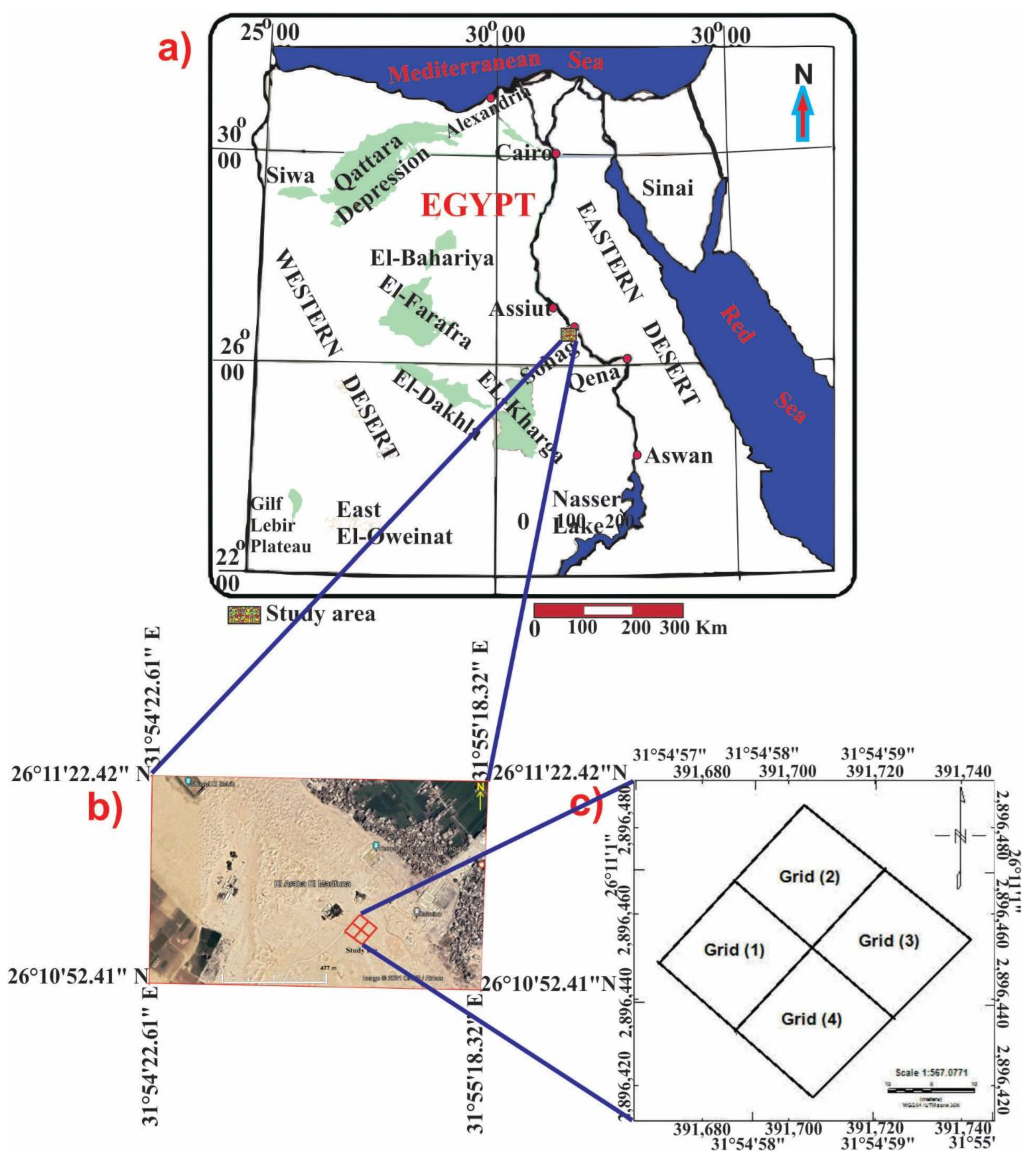
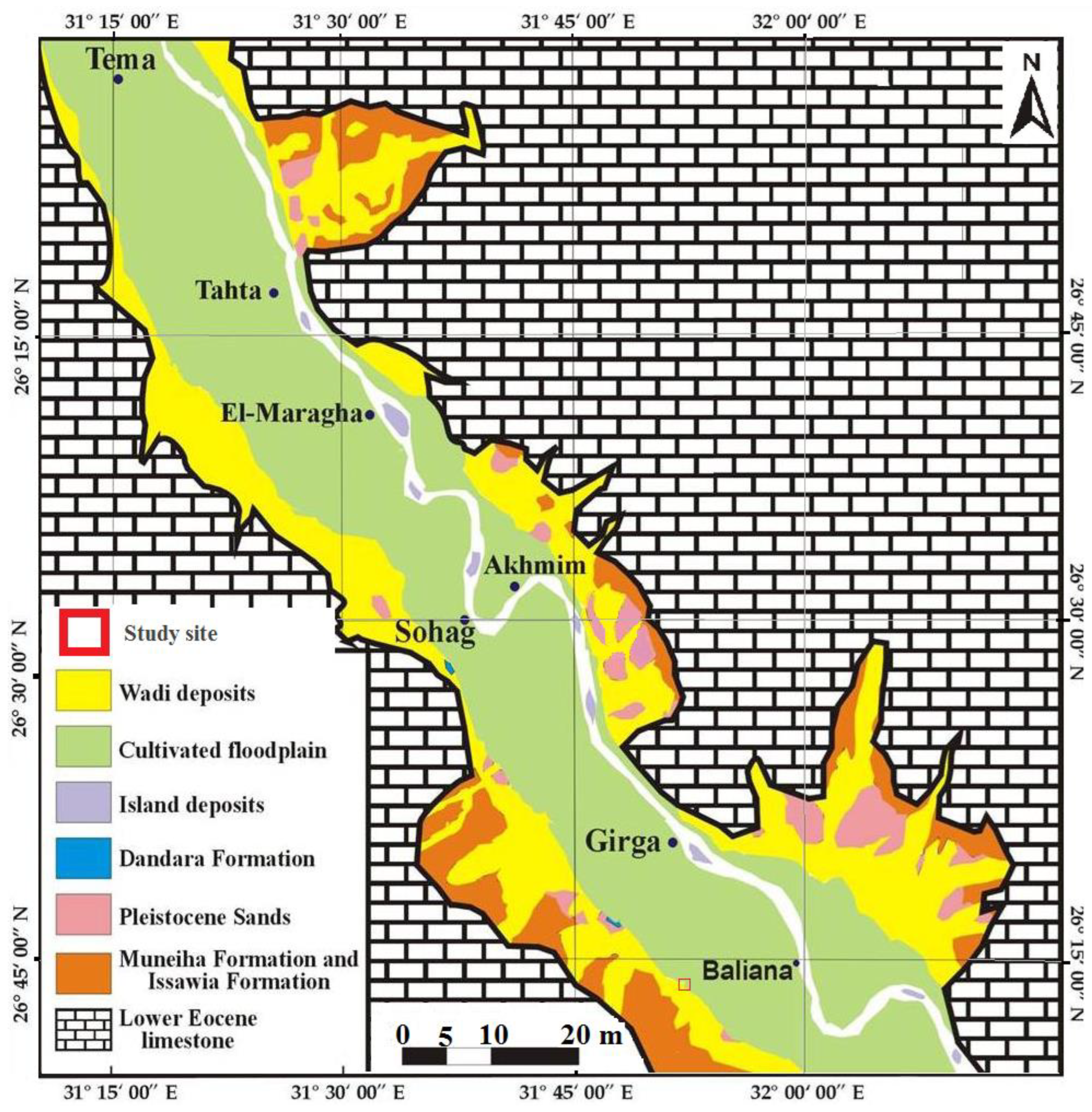
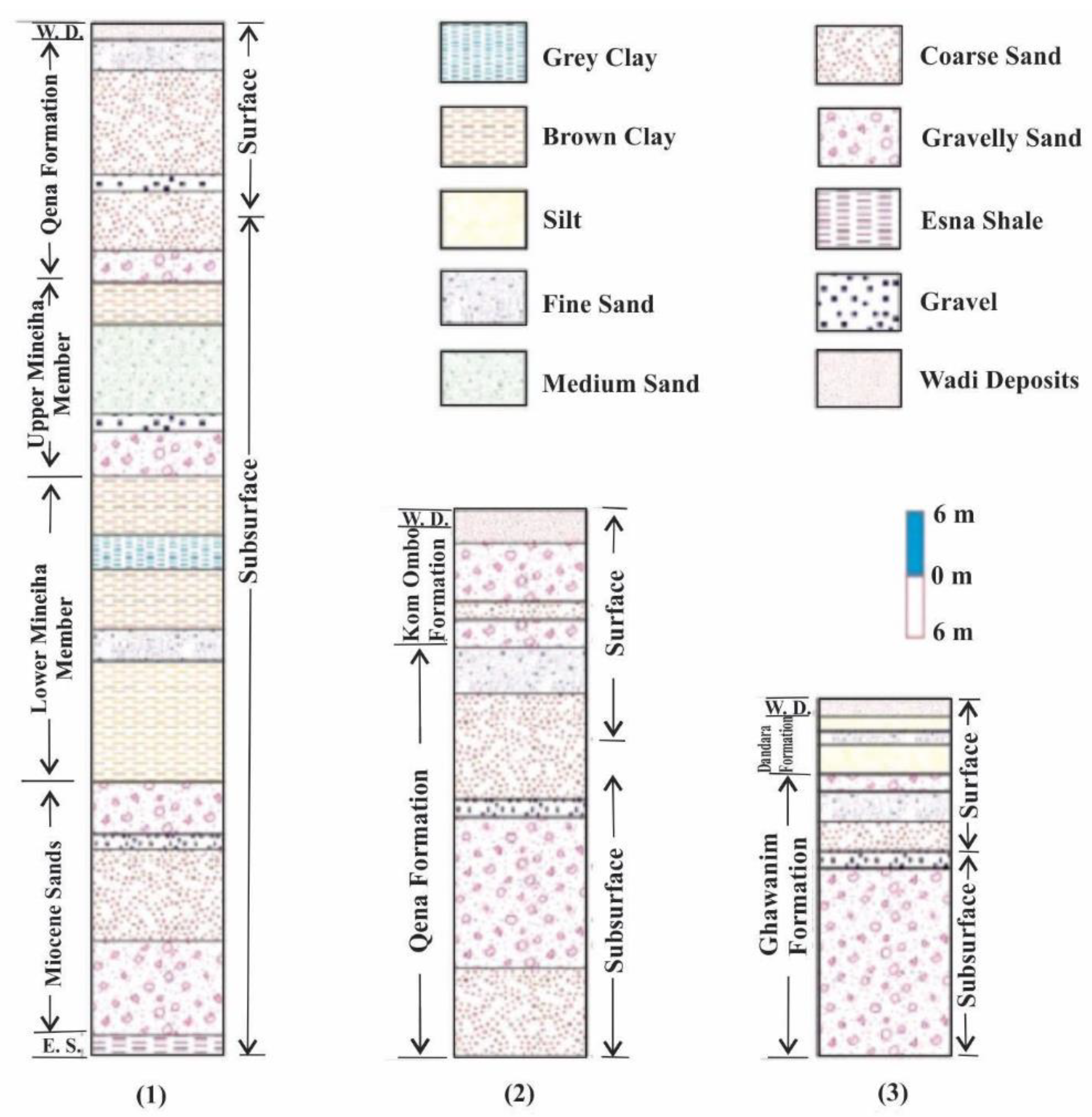

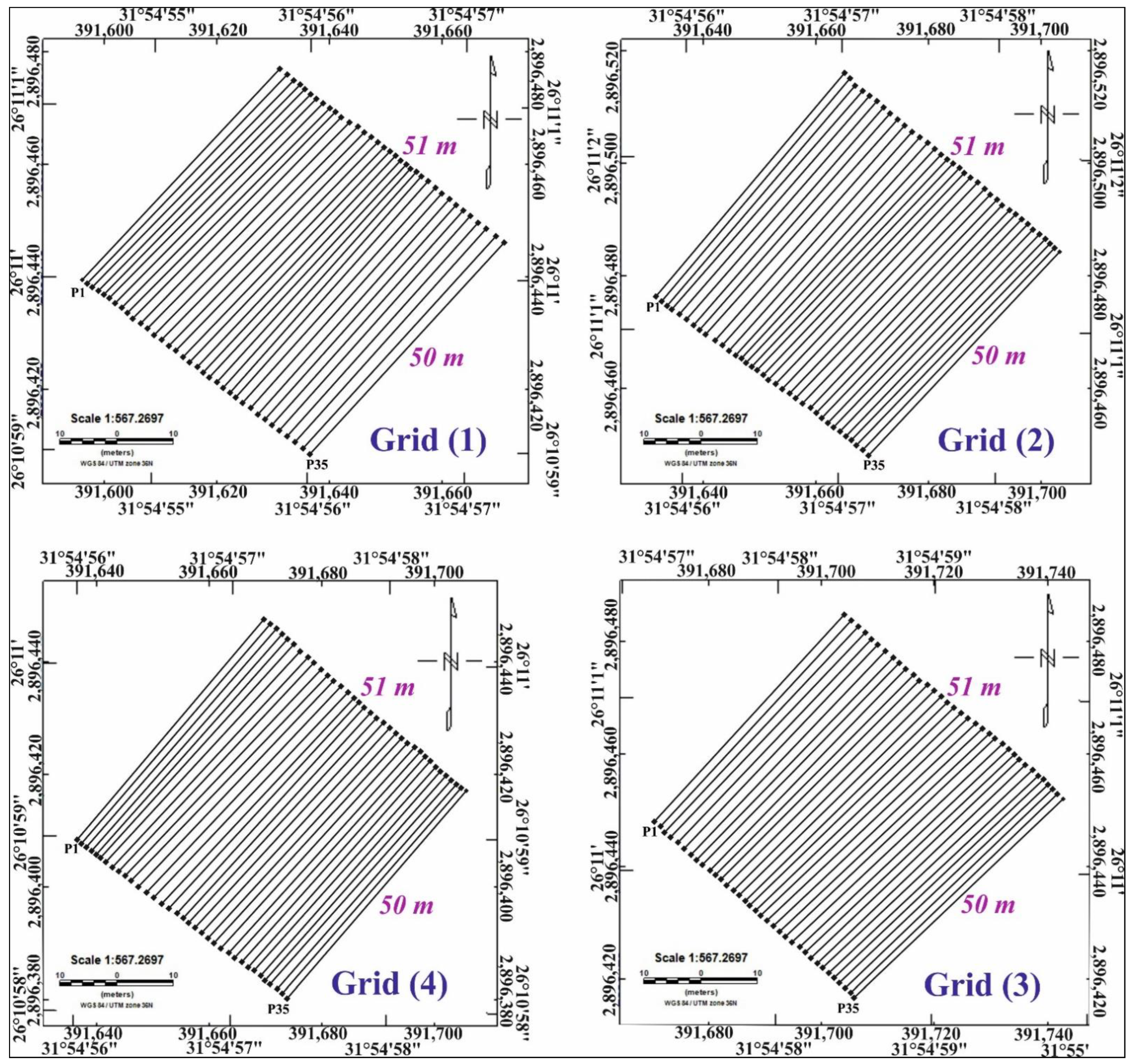

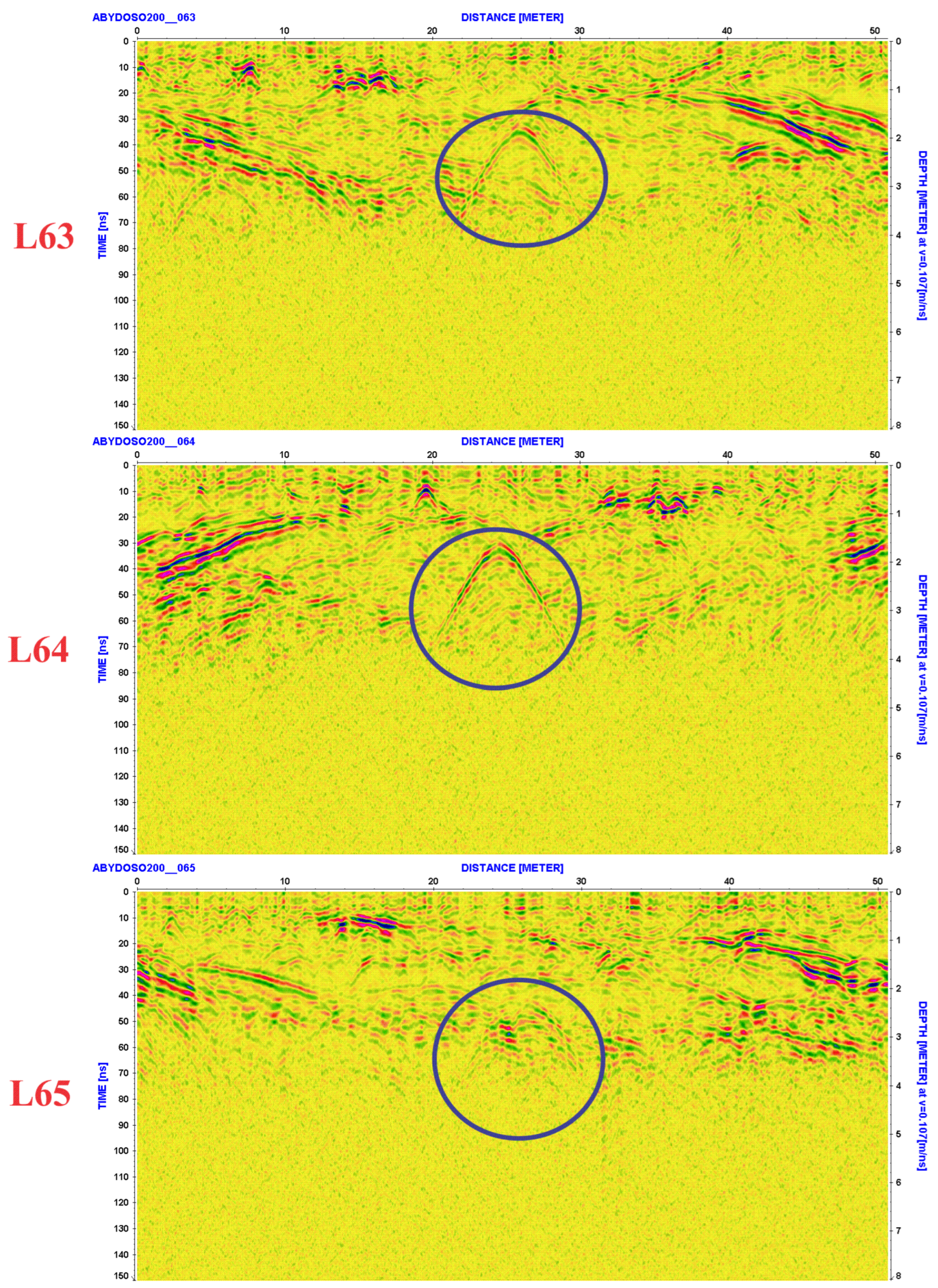
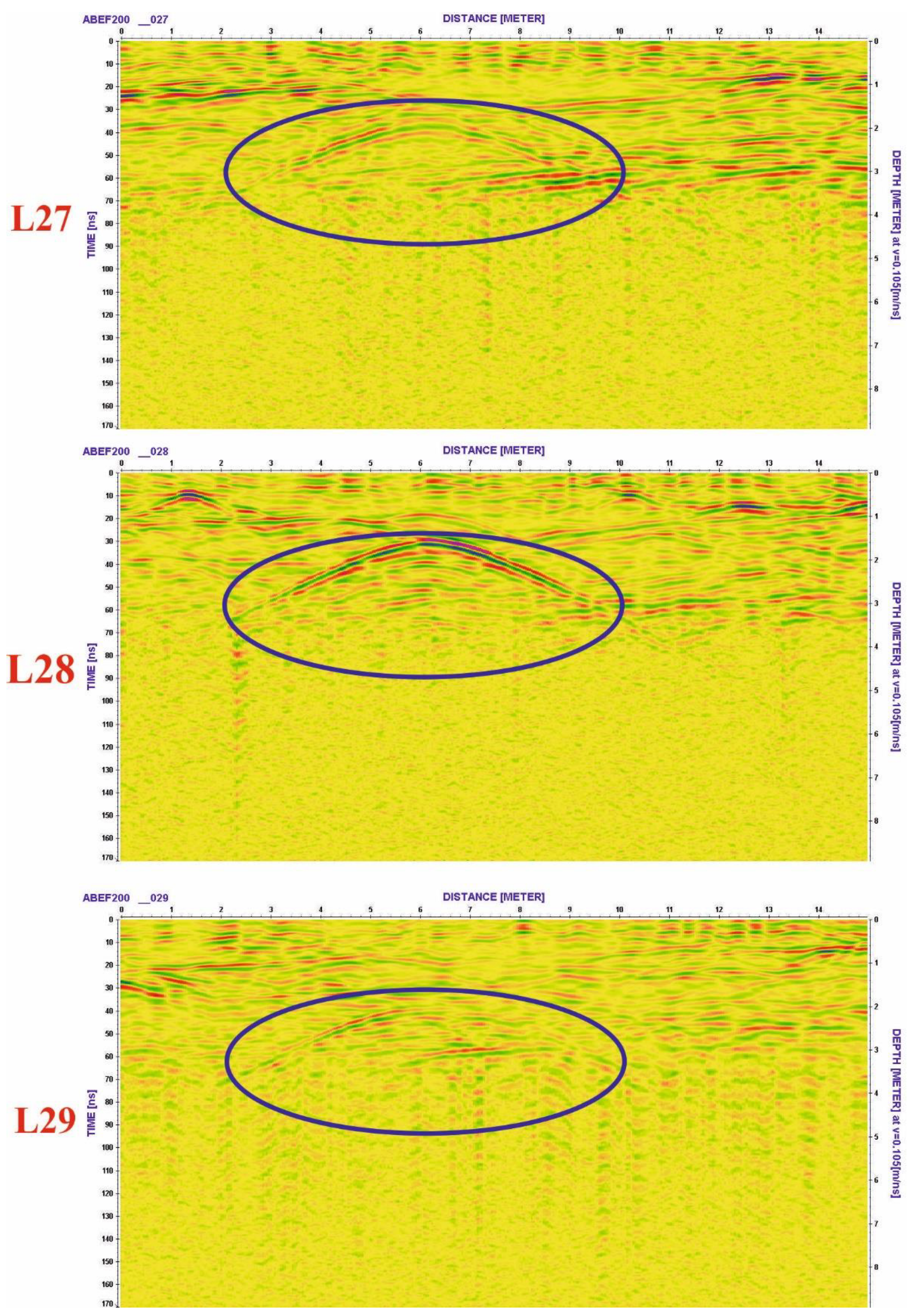
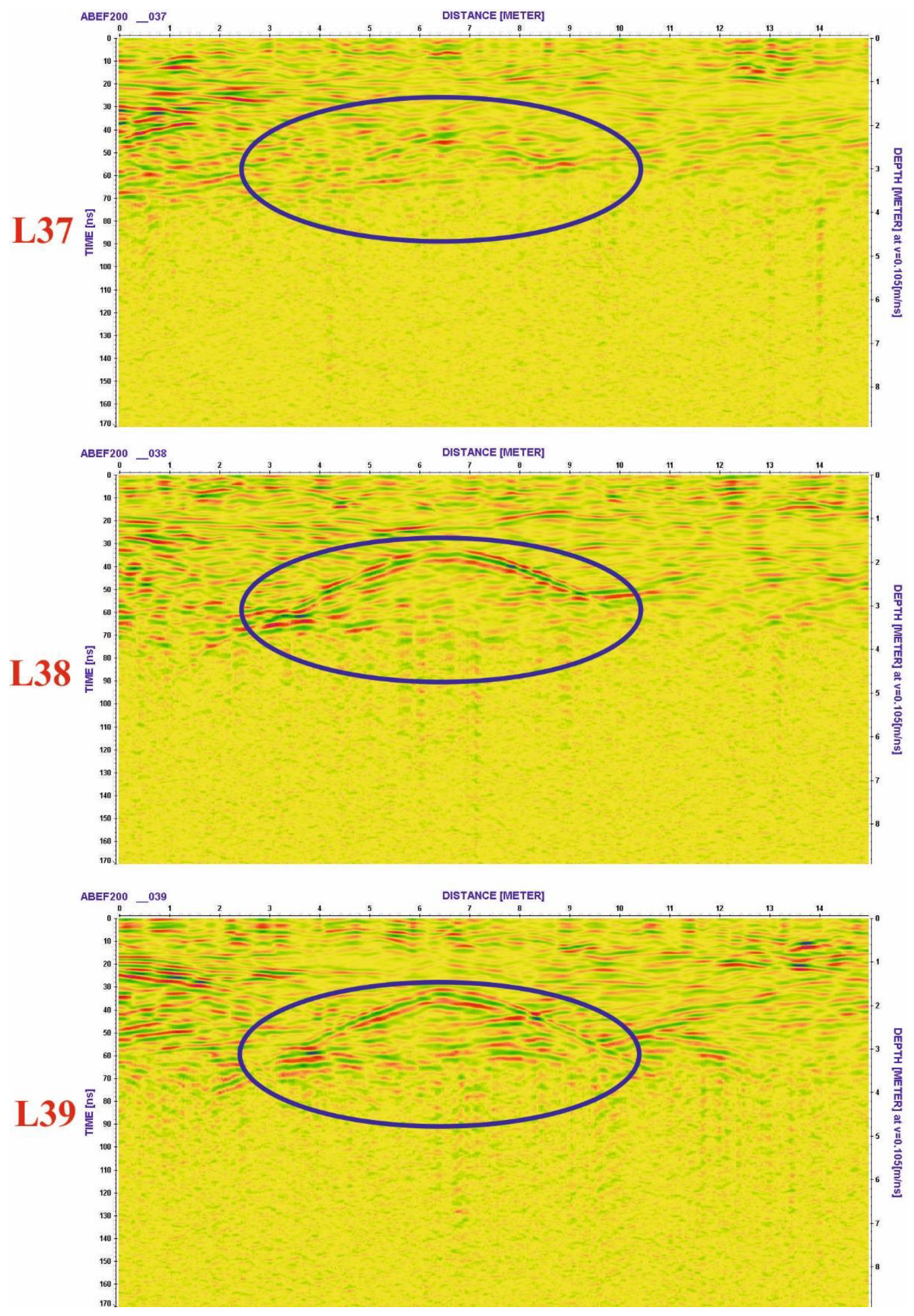
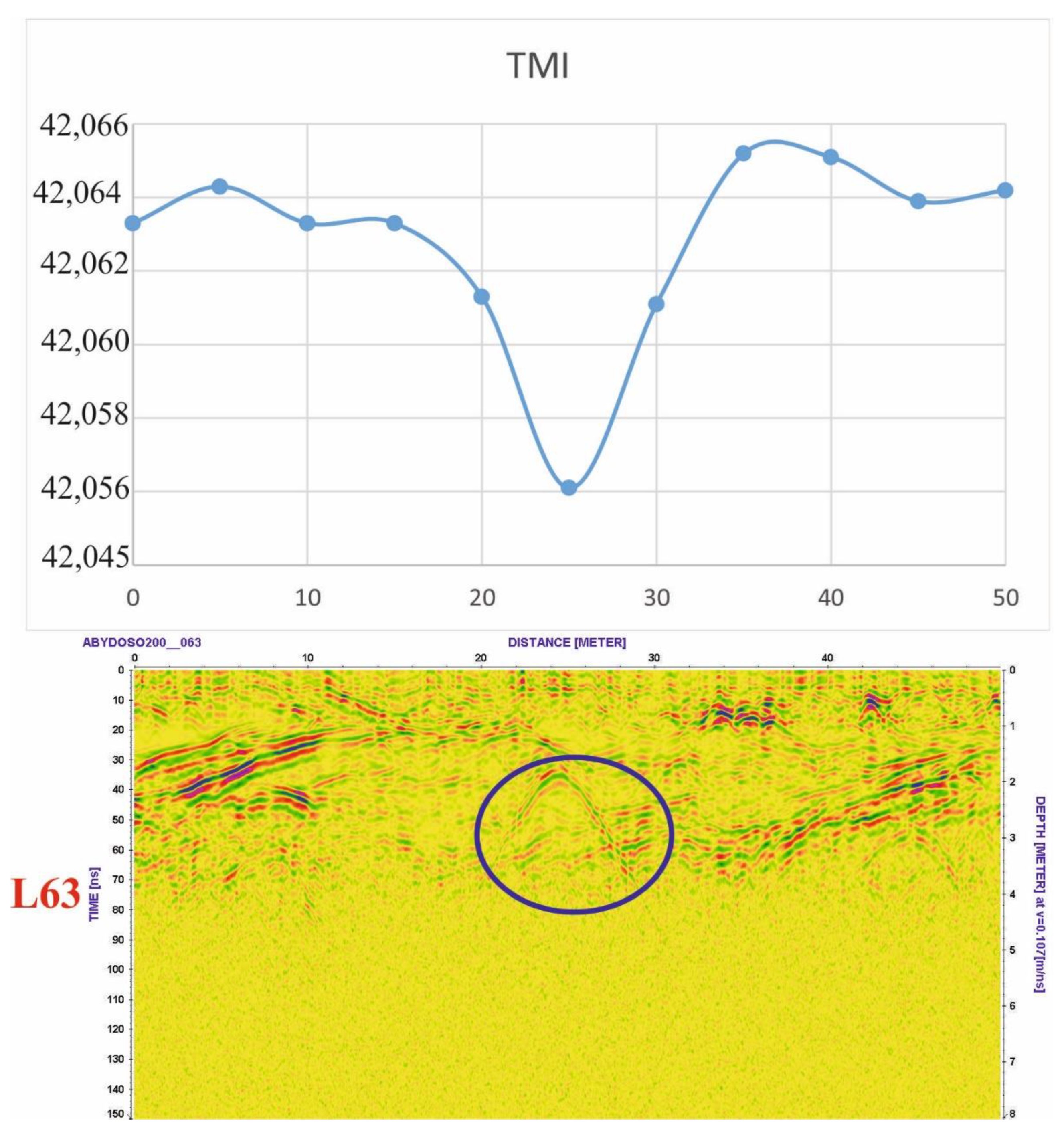

Publisher’s Note: MDPI stays neutral with regard to jurisdictional claims in published maps and institutional affiliations. |
© 2022 by the authors. Licensee MDPI, Basel, Switzerland. This article is an open access article distributed under the terms and conditions of the Creative Commons Attribution (CC BY) license (https://creativecommons.org/licenses/by/4.0/).
Share and Cite
Abudeif, A.M.; Abdel Aal, G.Z.; Masoud, M.M.; Mohammed, M.A. Geoarchaeological Investigation of Abydos Area Using Land Magnetic and GPR Techniques, El-Balyana, Sohag, Egypt. Appl. Sci. 2022, 12, 9640. https://doi.org/10.3390/app12199640
Abudeif AM, Abdel Aal GZ, Masoud MM, Mohammed MA. Geoarchaeological Investigation of Abydos Area Using Land Magnetic and GPR Techniques, El-Balyana, Sohag, Egypt. Applied Sciences. 2022; 12(19):9640. https://doi.org/10.3390/app12199640
Chicago/Turabian StyleAbudeif, Abdelbaset M., Gamal Z. Abdel Aal, Marwa M. Masoud, and Mohammed A. Mohammed. 2022. "Geoarchaeological Investigation of Abydos Area Using Land Magnetic and GPR Techniques, El-Balyana, Sohag, Egypt" Applied Sciences 12, no. 19: 9640. https://doi.org/10.3390/app12199640
APA StyleAbudeif, A. M., Abdel Aal, G. Z., Masoud, M. M., & Mohammed, M. A. (2022). Geoarchaeological Investigation of Abydos Area Using Land Magnetic and GPR Techniques, El-Balyana, Sohag, Egypt. Applied Sciences, 12(19), 9640. https://doi.org/10.3390/app12199640







